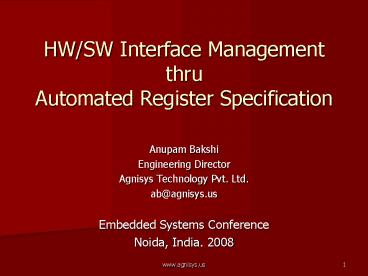HWSW Interface Management thru Automated Register Specification
1 / 27
Title:
HWSW Interface Management thru Automated Register Specification
Description:
89% of designs go over deadline by avg. 44% Parallel software ... HW Design VHDL/Verilog. HW Programming Guide MS Word/Excel. Verification Environment HVL/TCL ... – PowerPoint PPT presentation
Number of Views:17
Avg rating:3.0/5.0
Title: HWSW Interface Management thru Automated Register Specification
1
HW/SW Interface ManagementthruAutomated
Register Specification
- Anupam Bakshi
- Engineering Director
- Agnisys Technology Pvt. Ltd.
- ab_at_agnisys.us
Embedded Systems Conference Noida, India. 2008
2
Agenda
- Introduction
- HW design process
- The Problem
- Possible Solutions
- QA
3
Introduction
4
SoC/FPGA designs today
- Ever increasing design complexity
- IP (in-house/3rd party)
- Integration 30 of total development cycle
- Verification
- 60 of total development effort
- Increased Cost
- 80 cost is head-count related
- TTM pressures
- 89 of designs go over deadline by avg. 44
- Parallel software development
Source Spirit/NXP Dec 2007
5
FPGA/SoC System overview
- Device Driver, OS Kernel
- Creates Hardware abstraction
- Uses Hardware Protocols
- AMBA (AHB, APB)
- OCP-IP
- Proprietary
Software Application
Software API
HW/SW Interface
Hardware Protocol
Configuration Registers Hardware
6
System Design Process
Software Application
Integration
Software Design
Partitioning
Software API
Functional specification
HW/SW Interface
I/F Design
Hardware Protocol
Hardware Design
Configuration Registers Hardware
Correction iteration
7
System Design Process
Hardware Design
Spec
Programming guide or MS excel file
VHDL
Hardware Verification
System Diagnostics/Firmware
C/C Header
Application Software
8
Canonical Hardware System
9
Hardware Registers
- Hardware contains many Registers
- 100s Control applications
- 1000s Image Processing applications
- Registers Used for
- Configurations
- Control
- Status
- Why focus on Registers?
- Ubiquitous and essential
- Wide spread impact/ Quick ROI
- Low hanging fruit!
- Effects not just the hardware but software,
firmware,
10
The Problem
11
The Domino effect in HW design
12
The problem
- Many representations of the same register
information - Functional Specification MS Word/Frame
- HW Design VHDL/Verilog
- HW Programming Guide MS Word/Excel
- Verification Environment HVL/TCL
- Firmware C/C header
- Diagnostics C/C header
- Application Software C/C header
13
Problem Description (contd.)
- Problems with Register descriptions in multiple
places - Time consuming to create
- Additions/Changes are problematic
- Error prone
- Monotonous work
- Longer debug time
- Longer Hardware/Software integration times.
14
Problem Description (contd.)
- Number of register is large
- Changes are inevitable during design process
- Add/remove registers
- Register definition/bit fields
- Register location
- Register type (r, r/w, w1c, )
- Register implementation
15
Possible Solutions
16
What if we have
- One specification for all registers
- All representations generated from the single
source
17
Possible solutions
- Single description for all registers
- SPIRIT
- SystemRDL
- Implementation
- GUI based tools
- Eclipse based tools
- Editor based tools
18
SPIRIT
- Unified set of specification based on IP
meta-data - www.spiritconsortium.org
- Called IP-XACT
- XML Schema
- Language neutral
- Comprehensive data
- Components, Registers, Address spaces,
- Bus definitions, Ports,
19
SPIRIT Register description
ltspiritregistergt ltspiritnamegtstatuslt/spiritna
megt ltspiritdescriptiongtStatus
registerlt/spiritdescriptiongt
ltspiritaddressOffsetgt0x4lt/spiritaddressOffsetgt
ltspiritsizegt32lt/spiritsizegt
ltspiritvolatilegttruelt/spiritvolatilegt
ltspiritaccessgtread-onlylt/spiritaccessgt
ltspiritfieldgt ltspiritnamegtdataReadylt/spirit
namegt ltspiritdescriptiongtIndicates that new
data is available
in the receiver holding register
lt/spiritdescriptiongt ltspiritbitOffsetgt0lt/spi
ritbitOffsetgt ltspiritbitWidthgt1lt/spiritbitW
idthgt ltspiritaccessgtread-onlylt/spiritaccessgt
lt/spiritfieldgt ltspiritfieldgt lt!--
--gt lt/spiritfieldgt lt/spiritregistergt
20
SystemRDL
- Open specification
- www.denali.com
- Textual
- non-XML based
- New language
- Donated to Spirit
Reg chip1 name some reg desc some
desc field hw w sw r f170 8d5
field hw r sw w f2158 8d10
Addresmap blk1_admap name blk1 address
map in chip1 chip1 chip1_reg _at_0x0000
21
Automation in System Design
Register Spec
Hardware Design
Hardware Verification
RTL
Documentation Programmers guide Memory map
Automation
C/C Header
System Diagnostics/Firmware
Application Software
22
Automation in System Design (contd.)
C/C Header
C Classes
Synthesizable RTL
Register Spec
Auto
Verification tests
Diagnostic tests
Documentation (HTML/Word)
Mnemonic/hex address mapping
Future Generators
23
Benefits of Auto Register generation
- Fast
- Consistent
- Correct by construction
- Standardized VHDL and C code
- Complete, in-sync documentation
- Automatic register R/W tests
- Helps reusability
24
C/C Header file
- typedef struct
- union
- Newman_ColdfireInterface_s s
- hwi_uint32 filler0x200
- ColdfireInterface
- union
- reusememblock_s s
- hwi_uint32 filler0x200
- reusememblock
- union
- Newman_FrameBuffers_s s
- hwi_uint32 filler0x200
- FrameBuffers
- union
- Newman_genlock_s s
- hwi_uint32 filler0x200
- genlock
- union
- Newman_VideoCapture_s s
25
HTML output
26
Conclusion
- Manually creating multiple views of registers is
inefficient. - Automation enables us to maintain a single source
of register specification. - Automation streamlines the whole process with
better Hardware/Software Integration, Diagnostics
and Verification
27
Q/A































